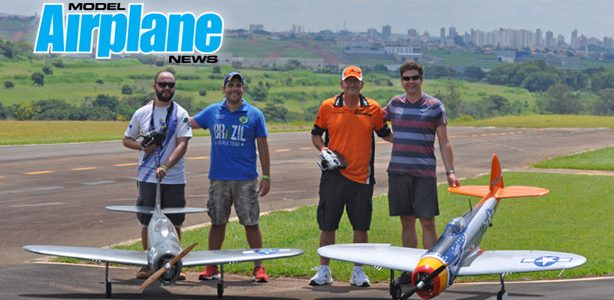(see photos below)
Here’s additional information for the impressive Fokker D-VII that was featured in the October 2009 Pilot Project section.
Joseph Bukovchik built this Balsa USA ¼ scale Fokker D-VII over one and a half years. It is powered with a Fuji 34 cc, 4 stroke, ignition engine with a wet sump. It weighs 21 pounds but is yet to be balanced. Guidance is provided a Futaba FAAST 6 channel 2.4 radio.
He painted the two different lozenge colorings on Solartex by making 5 color stencils. This is a most colorful airplane. The bright bottom lozenge pattern appears on the Fokker D-VII at the USAF Museum in Dayton, Ohio. It actually is this colorful in the bright sun! Mine was painted mostly with Jerry Nelson water-based polyurethane paint and acrylics.
He used copies of factory blueprints supplied by the San Diego Aero Space Museum to detail this plane. It has a full cockpit including a floor compass, a workable fuel pressure pump, working magneto switch and cocking mechanisms on the Spandaus. The guns are fabricated mostly from aluminum as are the anti-flash tracks that keep the muzzle flash from burning the top end of the Mercedes 160 hp engine. The pull-pull wires are threaded under the cockpit floor and exit through leather patches. The leather cockpit combing is sewn onto the fuselage. One of the gold-plated bezels is from an antique watch.
He had made a laser cut scale data plate on the lower right side of the cowl; the aileron wires are hidden inside the cabane struts. There are numerous access doors on the fuselage, and there are two gas caps because the plane’s gas tank has two filler pipes. The oil vent on top of the radiator is scaled from the blueprints.
The color scheme as provided by the San Diego Aero Space Museum shows white rubber tires. I used Williams Brothers white rubber wheels.
The blueprints show that the word Gesammt Gewicht was misspelled at the Dutch factory where it was built. They didn’t know enough German and there should only be one ‘m’ in Gesamt. My German son-in-law observed this mistake. I continued the error of the factory blueprints.
The data plate was laser cut by Blue World Industries @ www.blueworldindustries.com Chris Hazelton, the owner, can cut signs or instrument faces we use for our planes. Signs can be laser cut in metal or plastic that looks like metal. I obtained a photo of the data plate from an internet web site on the Fokker and Chris cut it from this photo very easily!
The rib stitches were applied, one at a time. Instead of sewing, each was applied by cutting an almost ¼” long thread, dipping it slightly in white glue with tweezers, and laying it on top of the wing rib. Since the original wing tapes had straight edges, it was easy to cut white Solartex 3/8” wide, and seal these tapes over the threads onto the covering. Thus, there was no need to paint the rib tapes.
The white rib tapes were not applied to the sub-wing because it was originally covered with plywood. A Fokker D-VII appears on the March 2006 cover of Model Aviation which inaccurately shows wing tapes on the sub-wing.
The tail skid is functional and is spring loaded with rubber bands. An access hatch under the skid allows the bands to be replaced as necessary. The spruce skid has a 1/8” spring steel wire around the area where it contacts the ground.
The ammo feed boxes were made from extra aluminum which came with the kit. These boxes were CA’d together and look like they were welded. The cockpit mounting step was made with 1/8” o.d. aluminum tubing. Toothpicks were inserted into them to provide a wood-to wood connection and they were CA’d together.
A craft store supplied the appropriate size decals, both the ‘rub-on’ and the ‘vinyl stick-on’ kinds. Thus, on the rear cabane struts and stabilizer supports, these small decals were applied. Some letters like the ‘k’ had to be cut to approximate the original lettering. The factory blueprints show the original lettering. They are a bit different than modern letters.
Arizona Model Aircrafters provided a cockpit kit and an engine kit for the Mercedes 160 hp. The exhaust manifold has some red iron oxide powder mixed with clear acrylic applied to approximate rust. When I was in Colorado, I found a red iron oxide stone in a stream. When I rubbed it, the water became red. Now I file a bit of the stone into powder and use it as pigment.
On the right side of the fuselage just behind the aluminum cowl siding is an access hatch for the radio, battery, etc. It is triangular and is attached with only one screw. One of the sides of the hatch has an interior lip which fits under a cross fuselage member.
The way the Fokker Company separated the cockpit area from the back of the plane was by sewing a large piece of lozenge wing covering material to the fuselage members directly behind the pilot. It goes from the top of the interior fuselage to the bottom and from one side to the next. Thus, I sewed a piece there too.
The internet has a site which features the restoration of a Fokker D-VII. The photos are invaluable. One site is: memorial.flight.free.fr There are many others and the serious scale modeler must view them for ideas.
Joseph Bukovchik, Vista, CA
























Cirrata,
All those words ………. and NO PICS?
Also, a STRIPPER may be more interesting than a Fokker
D-VII “Candy-Striper”. (Spelling counts!)